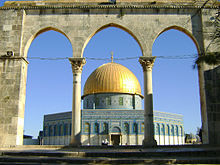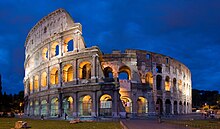Monument

The Great Pyramid of Giza built almost 5000 years ago as pharaoh'stomb, one of the Seven Wonders and enduring symbol of ancient Egyptian civilization since antiquity.

The Parthenon is regarded as an enduring symbol of Ancient Greece, the Athenian democracy, as well as the symbol of Western Civilization.

The Great Wall of China, a massive fortification structure that became the monument of Chinese civilization.

The Dome of the Rock, a shrine on theTemple Mount in the Old City of Jerusalem, covering the Foundation Stone which bears great significance for Jews, Christians and Muslims.
A monument is a type of - usually three-dimensional - structure that was explicitly created to commemorate a person or event, or which has become relevant to a social group as a part of their remembrance of historic times or cultural heritage, due to its artistic, historical, political, technical or architectural importance. Examples of monuments include statues, (war) memorials, historical buildings, archeological sites, and cultural assets. If there is a public interest in its preservation, a monument can for example be listed as a UNESCO World Heritage Site. [1]
Etymology
The origin of the word "monument" comes from the Greek mnemosynon and the Latinmoneo, monere, which means 'to remind', 'to advise' or 'to warn',[2] suggesting a monument allows us to see the past thus helping us visualize what is to come in the future.[3] InEnglish the word "monumental" is often used in reference to something of extraordinary size and power, as in monumental sculpture, but also to mean simply anything made to commemorate the dead, as a funerary monument or other example of funerary art.
Creation and functions
Monuments have been created for thousands of years, and they are often the most durable and famous symbols of ancient civilizations. Prehistoric tumuli, dolmens, and similar structures have been created in a large number of prehistoric cultures across the world, and the many forms of monumental tombs of the more wealthy and powerful members of a society are often the source of much of our information and art from those cultures.[4] As societies became organized on a larger scale, so monuments so large as to be difficult to destroy like the EgyptianPyramids, the Greek Parthenon, the Great Wall of China, Indian Taj Mahal or the Moai ofEaster Island have become symbols of their civilizations. In more recent times, monumental structures such as the Statue of Liberty and Eiffel Tower have become iconic emblems of modern nation-states. The termmonumentality relates to the symbolic status and physical presence of a monument. In this context, German art historian Helmut Scharf states that “A monument exists in the form of an object and also as symbol thereof. As a language symbol, a monument usually refers to something concrete, in some rare cases it is also used metaphorically [...]. A monument can be a language symbol for a unity of several monuments [...] or only for a single one, but in a broader sense it can also be used in nearly all knowable planes of being. [...] What is considered a monument always depends on the importance it attributes to the prevailing or traditional consciousness of a specific historical and social situation.”
Basically, the definition framework of the term monument depends on the current historical frame conditions. Aspects of the Culture of Remembrance and cultural memory are also linked to it, as well as questions about the concepts of public sphere and durability (of the one memorized) and the form and content of the monument (work-like monument). From an art historical point of view, the dichotomy of content and form opens up the problem of the “linguistic ability” of the monument. It becomes clear that language is an eminent part of a monument and it is often represented in “non-objective” or “architectural monuments”, at least with a plaque. In this connection, the debate touches on the social mechanisms that combine with Remembrance. These are acceptance of the monument as an object, the conveyed contents and the impact of these contents.
Monuments are frequently used to improve the appearance of a city or location. Planned cities such as Washington D.C., New Delhiand Brasília are often built around monuments. For example, the Washington Monument's location was conceived byL'Enfant to help organize public space in the city, before it was designed or constructed. Older cities have monuments placed at locations that are already important or are sometimes redesigned to focus on one. AsShelley suggested in his famous poem "Ozymandias" ("Look on my works, ye Mighty, and despair!"), the purpose of monuments is very often to impress or awe.
Structures created for others purposes that have been made notable by their age, size or historic significance may also be regarded as monuments. This can happen because of great age and size, as in the case of the Great Wall of China, or because an event of great importance occurred there such as the village of Oradour-sur-Glane in France. Many countries use Ancient monument or similar terms for the official designation of protected structures or archeological sites which may originally have been ordinary domestic houses or other buildings.
Monuments are also often designed to convey historical or political information, and they can thus develop an active socio-political potency. They can be used to reinforce the primacy of contemporary political power, such as the column of Trajan or the numerous statues of Lenin in the Soviet Union. They can be used to educate the populace about important events or figures from the past, such as in the renaming of the old General Post Office Building in New York City to the James A. Farley Building (James Farley Post Office), after former Postmaster GeneralJames Farley.[5] To fulfill its informative and educative functions a monument needs to be open to the public, which means that its spatial dimension as well as its content can be experienced by the public, and be sustainable. The former may be achieved either by situating the monument in public space or by a public discussion about the it and its meaning, the latter by the materiality of the monument or if its content immediately becomes part of the collective or cultural memory.
The social meanings of monuments are rarely fixed and certain and are frequently 'contested' by different social groups. As an example: whilst the former East German socialist state may have seen the Berlin Wall as a means of 'protection' from the ideological impurity of the west, dissidents and others would often argue that it was symbolic of the inherent repression and paranoia of that state. This contention of meaning is a central theme of modern 'post processual' archaeological discourse.
Protection and preservation
The term is often used to describe any structure that is a significant and legally protected historic work, and many countries have equivalents of what is called in United Kingdom legislation a Scheduled Monument, which often include relatively recent buildings constructed for residential or industrial purposes, with no thought at the time that they would come to be regarded as "monuments".
Until recently, it was customary forarchaeologists to study large monuments and pay less attention to the everyday lives of the societies that created them. New ideas about what constitutes the archaeological recordhave revealed that certain legislative and theoretical approaches to the subject are too focused on earlier definitions of monuments. An example has been the United Kingdom'sScheduled Ancient Monument laws.
Other than municipal or national government that protecting the monuments in their jurisdiction, there are institutions dedicated on the efforts to protect and preserve monuments that considered to possess special natural or cultural significance for the world, such as UNESCO's World Heritage Siteprogramme[6] and World Monuments Fund.[1]
Types
- Buildings designed as landmarks, usually built with an extraordinary feature, such being designed as the tallest, largest, or most distinctive design, e.g., the Burj Khalifa in Dubai, the world's tallest structure.
- Cenotaphs (intended to honor the dead who are buried elsewhere) and other memorialsto commemorate the dead, usually war casualties, e.g., India Gate and Vimy Ridge Memorial, or disaster casualties, such as the Titanic Memorial, Belfast.
- Church monuments to commemorate the faithful dead, located above or near their grave, often featuring an effigy, e.g., St. Peter's Basilica or the medieval church Sta Maria di Collemaggio in L'Aquila.
- Columns, often topped with a statue, e.g.,Berlin Victory Column, Nelson's Column in London, and Trajan's Column in Rome.
- Eternal flames that are kept burning continuously, usually lit to honor unknown soldiers, e.g., at the Tomb of Unknown Soldier in Moscow or at the John F. Kennedy gravesite in Virginia's Arlington National Cemetery.
- Fountains, water-pouring structures usually placed in formal gardens or town squares, e.g., Fontaines de la Concorde and Gardens of Versailles.
- Gravestones, small monuments to the deceased, placed at their gravesites, e.g., the tombs and vaults of veterans in Les Invalides and Srebrenica Genocide Memorial.
- Mausoleums and tombs to honor the dead, e.g., the Great Pyramid of Giza, Libyco-Punic Mausoleum of Dougga and Taj Mahal.
- Monoliths erected for religious or commemorative purposes, e.g.,Stonehenge.
- Mosque Monuments, places of worship that generally have domes and minaretsthat stand out against the skyline. They also usually feature highly skilled Islamic calligraphy and geometric artwork, e.g., theMosque of the Prophet.
- Mounds erected to commemorate great leaders or events, e.g., Kościuszko Mound.
- Obelisks, usually erected to commemorate great leaders, e.g., Cleopatra's Needle in London, the National Monument ("Monas")in Central Jakarta, and the Washington Monument in Washington, D.C.
- Palaces, imposing royal residences designed to impress people with their grandeur and greatness, e.g., Forbidden Cityin Beijing, Palace of Versailles, andSchwerin Palace in Schwerin.
- Searchlights to project a powerful beam of light, e.g., Tribute in Light in the National September 11 Memorial & Museum in New York City, commemorating the September 11 attacks of 2001.
- Statues of famous individuals or symbols, e.g., the Niederwalddenkmal (Germania) in Hesse, Liberty Enlightening the World(commonly known as the Statue of Liberty) in New York City, and The Motherland Callsin Volgograd.
- Temples or religious structures built for pilgrimage, ritual or commemorative purposes, e.g., Borobudur in Magelang andKaaba in Mecca.
- Terminating vistas, layout design for urban monuments on the end of an avenue, e.g.,Opera Garnier in Paris.
- Triumphal arches, almost always to commemorate military successes, e.g., theArch of Constantine in Rome and Arc de Triomphe de l'Étoile in Paris.
- War memorials, e.g., the Iwo Jima Memorialin Arlington, VA, the Laboe Naval Memorial, the Lorraine American Cemetery and Memorial in St Avold,[8] and the Soviet War Memorial in Berlin.




















Comments
Post a Comment